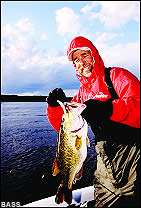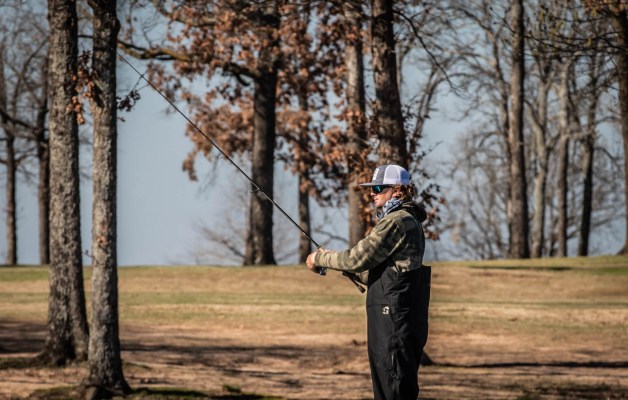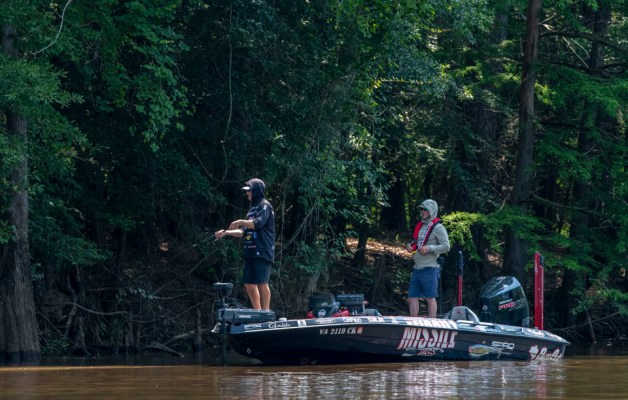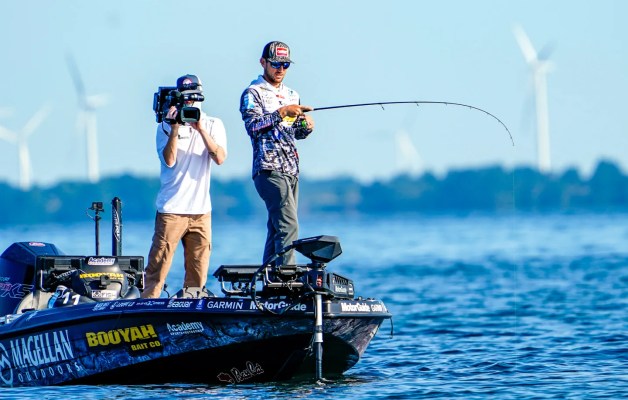
"Why are so many lunkers taken in the winter? … Maybe the big ones let their guard down at this season." — Bassmaster Magazine, January/February 1972.
For more than 30 years, that has been the common notion. And it even applies on lakes with crystal-clear water.
"It can be awesome," praises 22 time Bassmaster Classic qualifier Gary Klein, who grew up fishing the deep, clear waters of California's Lake Oroville. "Winter is one of my favorite times, especially for clear man-made reservoirs."
"There's a lot to like about cold, clear water," adds top female pro Penny Berryman, a student of Arkansas' lakes Ouachita and Dardanelle. "On deep, clear lakes the bass tend to bunch up more in the winter, so you'll find them in schools.
"In the summer, I might find them at a certain level, but they may be scattered all over a big, expansive flat. That means I've got to fish for half a mile at the same level because the fish are roaming more. In the summer, their metabolism is higher and they feed more. So, that makes them a little harder to pinpoint than in the winter. Cold, clear water can be so much fun."
"If I had my choice of a deep, clear lake that's 40 degrees or a shallow, muddy lake that's 40 degrees, I'll take the clear lake every time," Michigan's Kevin VanDam chimes in. "You can still catch them pretty strong in the wintertime."
Missouri pro Chad Brauer emphasizes that the water never gets too cold to catch largemouth. As evidence, he cites his experience of coaxing strikes in temperatures in the 30s, as well as the success of northern ice fishermen.
The BASS tournament winner says the biggest challenge involved in probing cold, clear water is in utilizing light line with downsized tackle and lures. But downsizing is not as big a factor in wintertime temperatures as it is during warmer times.
Generally, clear water winter fishing involves fairly deep water.
"During the colder months, clear water is best," past Classic champion and former fisheries biologist Ken Cook notes. "I look for the clearest water I can find."
Klein rarely targets winter largemouth in less than 15 feet from December through early March in clear water reservoirs. And it is not uncommon for him to score at depths ranging from 40 to 80 feet.
Brauer, whose home water is Lake of the Ozarks, has found that he can consistently catch coldwater bass in 25 feet or less. But, he points out that in winter the water column is basically the same in terms of temperature and oxygen content from top to bottom, so both largemouth and baitfish can be as deep as they desire. For example, on Table Rock Lake, bass often will be found 60 to 90 feet deep, but on Lake of the Ozarks the baitfish tend to be considerably shallower.
"Over the years, I've noticed that the key is locating some sort of shad pattern," Berryman says. "If you find the baitfish, it can become a situation where you cast to the area and catch as many as you want."
During the coldest months in most clear bodies of water, both the baitfish and largemouth will be relating to vertical structure, according to Klein. This type of habitat seems preferable to the sluggish bass, which can easily adjust their depth without exerting much energy.
"I think probably the most important thing about fishing clear lakes in the wintertime is understanding your electronics," the two time CITGO Bassmaster Angler of the Year states. "That time of the year, a high percentage of the fish are offshore. And when those fish are offshore, your electronics really come into play, because it basically shows you everything that's underneath you.
"The largemouth are going to be deep if deep water is available. And most anglers throughout the country, as much as they like to think that they are deep water anglers, are not very good at disseminating offshore hot spots. When the fish get deeper than 20 or 25 feet, many anglers don't have that relationship or that feel for what's below them. It all begins with being able to read your electronics."
Klein prefers to fish vertical presentations during the chilly season, opting for subtle techniques like a spoon or drop shot. "By fishing vertically, I can see everything take place on my electronics below me. I can see the fish come into the screen. I can see the fish approach the bait, feel the strike and catch him. So it's very exciting."
Berryman's approach usually involves following major creek channels or the main river artery while scrutinizing the bends for any kind of cover (especially standing timber or laydowns).
Veteran Missouri pro Stacey King is a big fan of fishing bluffs throughout the coldest months. Those broad-based banks or cliffs made of rock, mud or clay, which are common in midland and highland reservoirs, are attractive to largemouth because rock radiates warmth from the sunlight. Plus, bluffs feature boulders, chunk rock, sheer walls and outcroppings that provide prime ambush positions.
Cold, clear water brings out a different Kevin VanDam. Instead of being the fast, power fisherman who prides himself on being able to quickly cover vast areas, the former Classic champion spends most of his time idling around while studying his Pinpoint liquid crystal graph as he searches for "where a main creek hits the main river on main river points and off bluff ends. Deep valleys and coves along steep channel banks are great areas. I'm fishing close to the main river channel or main creek channels, trying to find intersections, junctions and things like that."
The transformation is completed when we learn that VanDam's No. 1 tool for catching cold, clear water largemouth is a jigging spoon.
"A spoon, for me — a guy that likes to fish a little faster and cover more water — is a much more efficient way to find those fish," he explains. "If I can find bass relating to a channel drop or where baitfish are relating to the channel drop, that's where I have a lot of confidence when I drop that spoon down.
"The second thing that I really like to do (especially once I've caught several fish on the spoon, because a lot of times that school will bust up) is throw a drop shot rig, if you can believe it. Over the last couple of years, I've learned the effectiveness of a drop shot. I don't claim to be an expert with it by any means, but I've asked the guys that are experts and I've learned quite a bit. To me, it's really important to match the type of bait that you use to the forage, both in size and style. So, I pretty much just use a little 4-inch straight-tail worm in (Strike King's) 3X material, which has tremendous action compared to a lot of plastics."
Whether drop shotting or spooning, VanDam emphasizes the value of using 6- to 8-pound-test fluorocarbon line. The low-stretch line is practically invisible and provides ultrasensitivity.
Regardless of the lure, Classic winner and former Angler of the Year Jay Yelas reminds us of the need to fish s-l-o-w-l-y. In water temperatures less than 50 degrees, a largemouth has to eat just once every 14 days, so the vast majority of its time is spent being inactive.
"Slow is definitely the key anytime you're in cold water with any kind of bait," he confirms. "Wintertime largemouth are just not going to chase a bait."
One of Chad Brauer's standard wintertime patterns involves methodically crawling a brown 1/2-ounce Strike King Pro Model jig (with its skirt drastically trimmed) with a small Denny Brauer 3X chunk trailer along deep, rocky banks. Hot spots for the jig are the ends of bluffs, where he casts into the shallowest rocks and then uses his reel to slowly drag the jig down into deeper water.
When largemouth living in clear water environments won't aggressively strike a jig, Yelas immediately follows up with a Carolina rig (with a 12-pound-test Vanish fluorocarbon leader towing a Berkley Power Noodle or floating worm).
Believe it or not, cold, clear water does not always involve fishing deep water.
"There is a shallow bite in the wintertime on clear lakes," Brauer claims. "It may not necessarily mean that the fish are up in the backs of the coves or up on the shallower flats. But those fish might be 5 feet deep or less, on a bluff bank where your boat might be sitting in 40 feet of water.
"Also, you get two or three days in a row of sunny weather, and those fish will come up to that warmer surface water and sit on those rock ledges. That's what I call a shallow wintertime bite. You can catch those fish on a suspending jerkbait or by pitching a jig up on those rock ledges and working it off. And sometimes it will even warm up enough to where you can catch them on a crankbait or a slow rolled spinnerbait in those situations."
On the warmer winter days, when the largemouth come shallow, Brauer can most often be found flinging a Strike King Wild Shiner jerkbait. With a pearl or chrome body and black or blue back, the 5 1/2-inch minnow-shaped bait closely resembles the big gizzard shad that typically die off during the coldest months in Lake of the Ozarks and other Missouri waters.
Shallow or deep, largemouth bass in cold, clear water can be caught surprisingly well with the right approach and a big dose of patience.
Action heats up on power plant lakes
During one of the toughest times of the year to catch fish, power plant lakes create a winter oasis for both bass and bass fishermen. The warmwater-release reservoirs and their artificial temperature zones create a superb cold weather habitat for bass.
"The beauty of power plant lakes is as simple as it can be," emphasizes Gary Giudice, an avid bass angler and power plant lake expert. "Being cold-blooded, bass shut down in the winter, but these warmwater discharges simply keep the fish much more active.
"In the wintertime, when all of the other lakes around here are just supertough places to catch fish, it's often a completely different story on the power plant lakes. They are much more dependable than the surrounding lakes."
Man has helped supercharge nature in the bodies of water scattered throughout the country that are used as cooling mechanisms by coal, gas and nuclear power plants. The warmwater discharge from these power generation facilities provides reliable, enjoyable fishing.
Texas has been the most aggressive state when it comes to building power plant lakes and managing their inhabitants. Most of these lakes have been stocked with the fast growing Florida strain of largemouth bass. Lakes Monticello and Welch, located about 15 miles apart, are the best known in Texas. But consider that Gibbons Creek Reservoir has surrendered bass weighing 13 and 16 pounds in the recent past.
Other prime power-influenced waters in Texas include: Fayette County, Granbury, Ray Hubbard, Fairfield, Arlington, Bastrop, Nasworthy, Twin Buttes, Calaveras and Fort Phantom Hill.
Additional outstanding warmwater winter fisheries include: Lake Sinclair in Georgia; Oklahoma lakes Konawa and Sooner; Lake Dardanelle in Arkansas; North Carolina's Lake Norman; the Duke Power Co. lakes scattered throughout the Carolinas; Virginia's James River and Lake Anna; and Indiana's Turtle Creek Reservoir.




